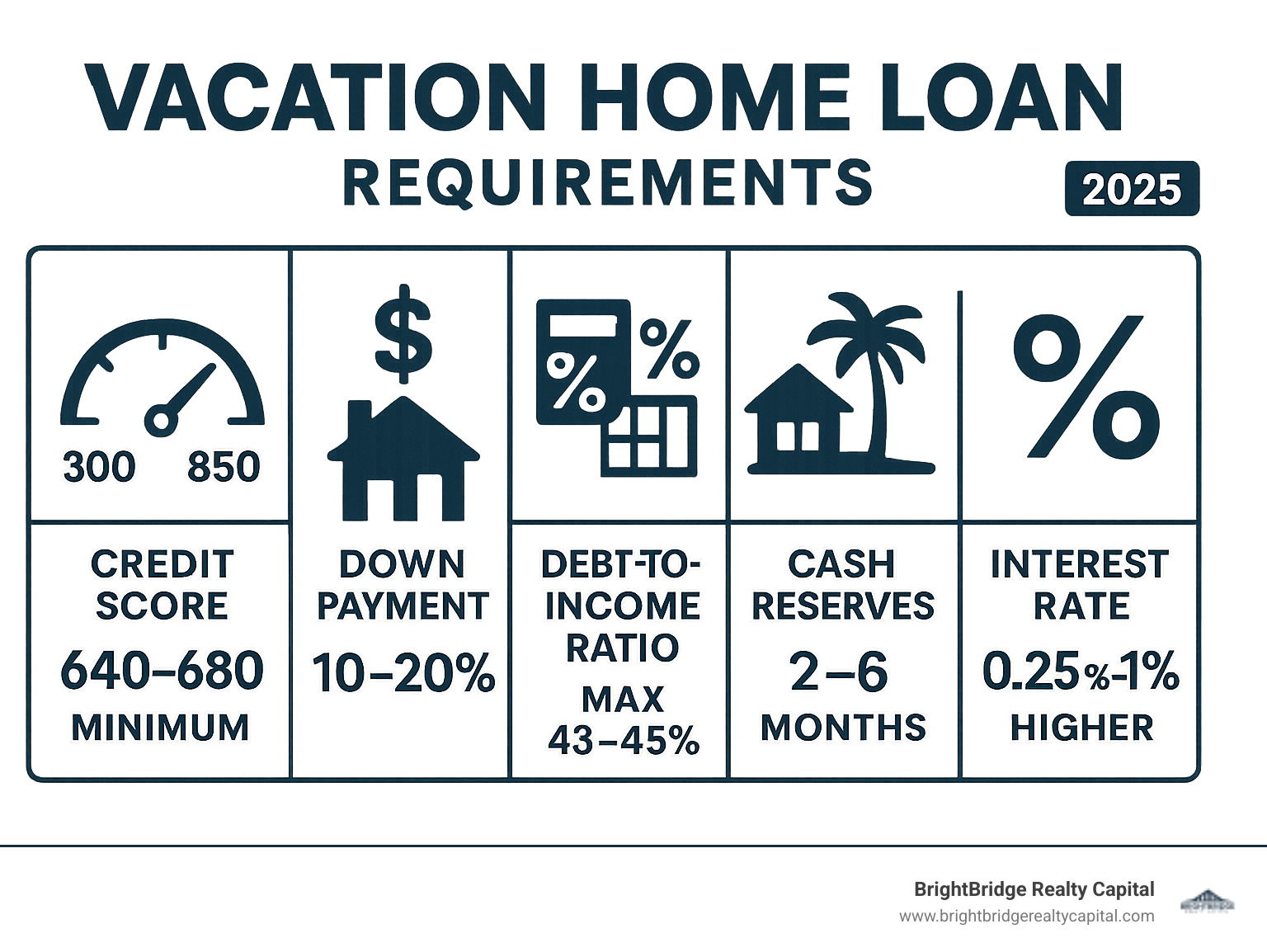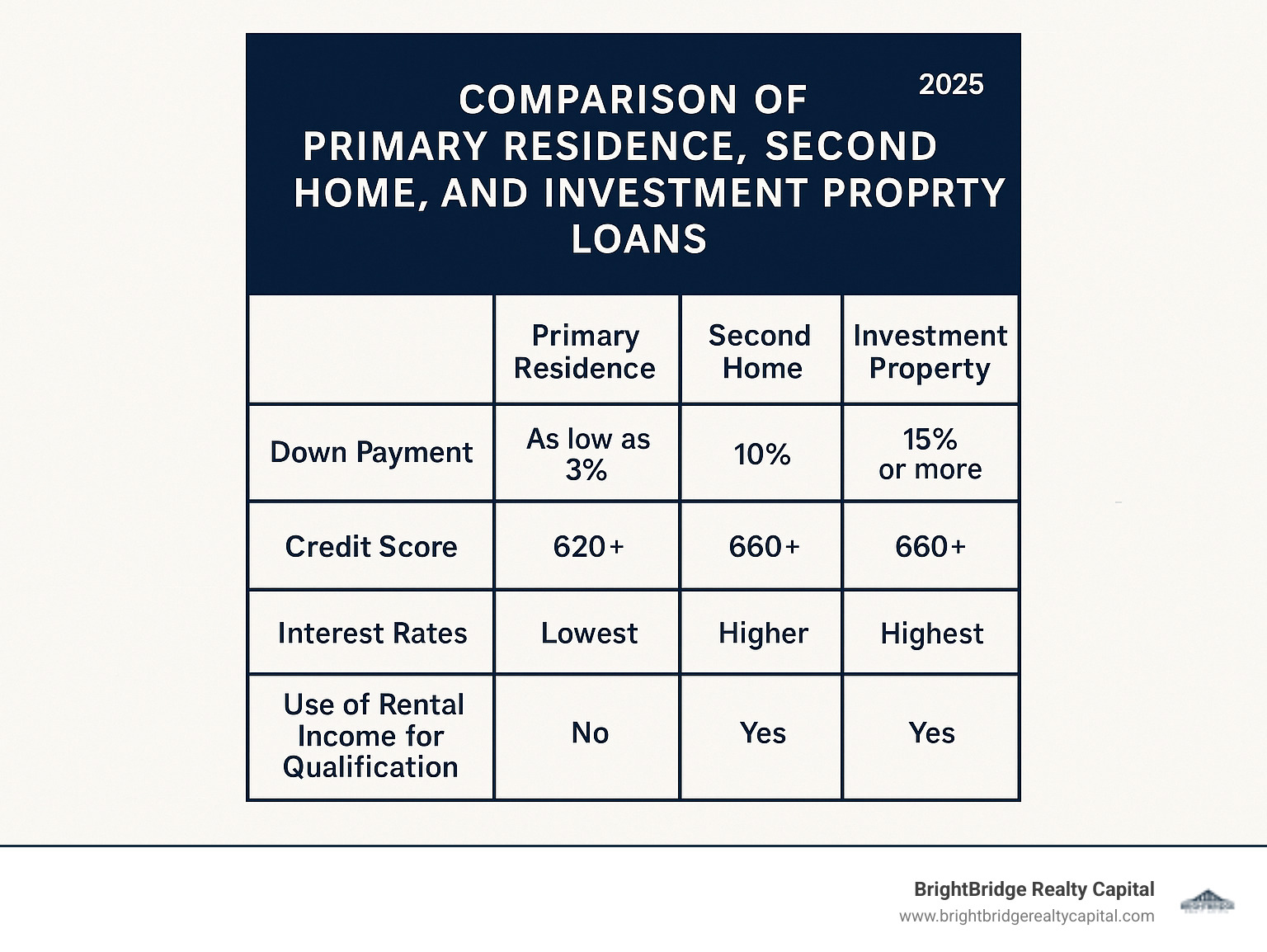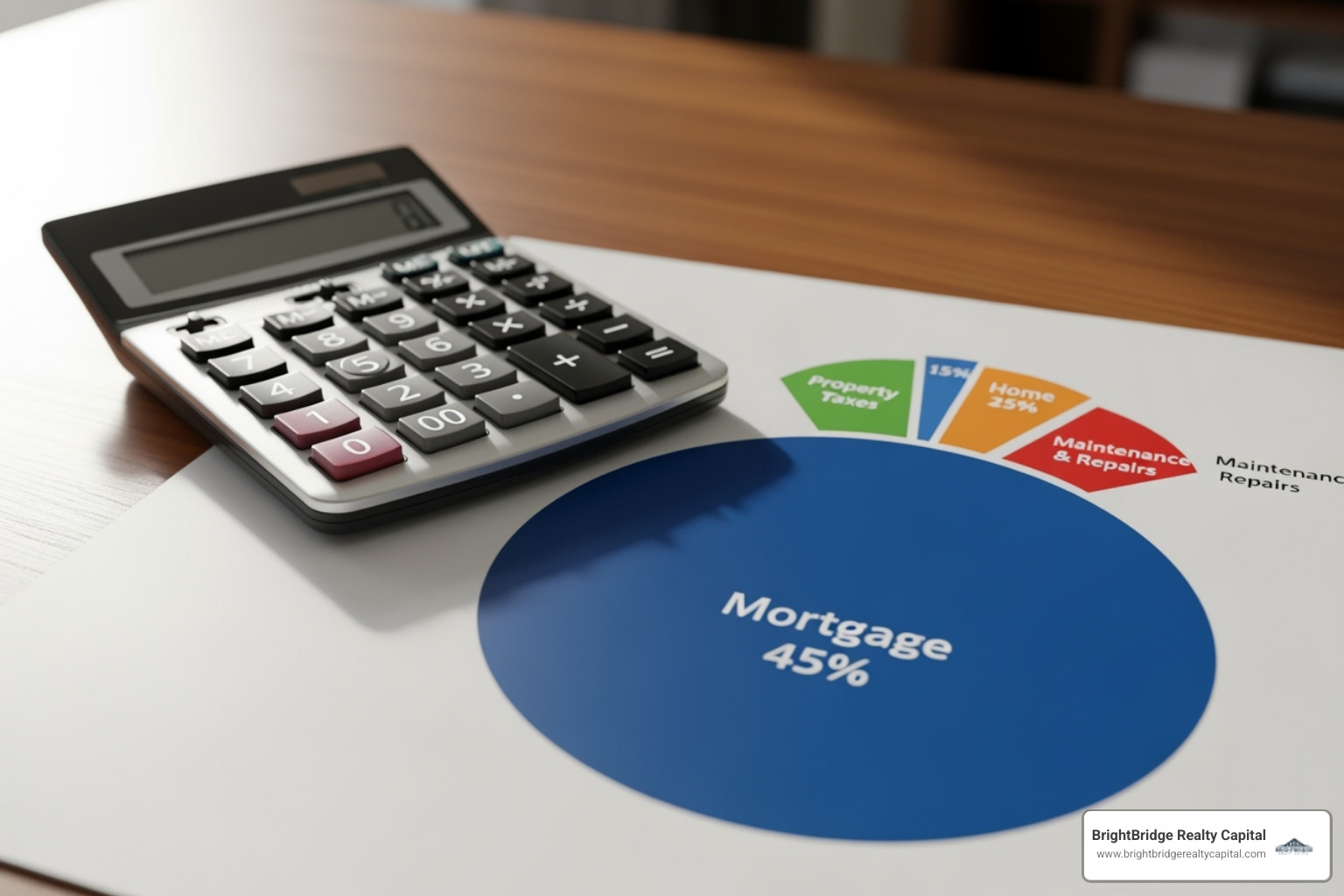Escape to Paradise: Financing Your Vacation Home

Why Vacation Home Ownership Makes Financial Sense
A vacation home loan is more than just a financing tool; it's a key that unlocks a unique blend of personal enrichment and financial growth. For many, a vacation home represents a personal retreat—a cherished sanctuary for creating lasting memories with family and friends, a guaranteed getaway from the daily grind, and a powerful tool for improving mental well-being. Beyond these invaluable lifestyle benefits, a second home can be a cornerstone of a diversified investment strategy, helping you build wealth through property appreciation and potential rental income. While financing a second home involves stricter lending requirements than a primary residence, the significant lifestyle and investment advantages make it a compelling goal for many.
Key Requirements for a Vacation Home Loan:
- Credit Score: A minimum score of 640-680 is typically required, but higher scores (740+) are necessary to secure the most competitive interest rates.
- Down Payment: Expect a minimum down payment of 10-20%. Providing 20% or more is often the benchmark for the best loan terms and helps you avoid private mortgage insurance (PMI).
- Debt-to-Income (DTI) Ratio: Lenders will want to see that your total monthly debt payments (including your new mortgage) do not exceed 43-45% of your gross monthly income.
- Cash Reserves: You'll need to prove you have 2-6 months of mortgage payments (for both homes) in liquid assets after closing.
- Property Type: The property must be a single-unit dwelling, like a house or condo, intended for year-round use.
- Occupancy: To qualify as a second home, you must intend to personally use the property for at least 14 days per year.
The rise of remote and hybrid work has dramatically fueled the appeal of vacation homes. Many buyers now seek properties that can seamlessly transition between a personal getaway and an income-generating asset. The proliferation of user-friendly rental platforms like Airbnb and Vrbo has made it easier than ever to monetize your property when you're not using it. Historically, real estate has proven to be a resilient and sound long-term investment, and vacation homes offer a tangible asset that you can enjoy while it appreciates. Furthermore, with proper planning, they can provide unique tax advantages that are unavailable with other types of investments.
It's important to note that interest rates for vacation homes typically run 0.25% to 1% higher than those for primary residences. This premium reflects the increased risk lenders perceive with a second property. However, the powerful combination of long-term property appreciation and supplemental rental income can often more than offset these higher borrowing costs, making it a financially savvy move.
I'm Daniel Lopez, a loan officer at BrightBridge Realty Capital. My expertise in vacation home loan products is specifically tailored to help investors and second-home buyers navigate this complex market. We specialize in securing competitive rates and closing deals efficiently, ensuring you can start enjoying your new property as soon as possible.

Vacation home loan terms explained:
Understanding the Requirements for a Vacation Home Loan

Securing a vacation home loan is a more rigorous process than financing a primary residence. Lenders view vacation homes as a higher risk because, in times of financial hardship, borrowers are statistically more likely to default on a second mortgage before their primary one. This perception of elevated risk is the driving force behind the stricter qualification standards that influence every aspect of vacation home financing.
A critical first step is understanding the distinction between a second home (a property for personal enjoyment) and an investment property (a property purchased primarily to generate rental income). A vacation home, even one you plan to rent out occasionally, is typically classified as a second home. This classification is paramount, as it dictates the loan terms, interest rates, and qualification requirements you'll face. Lenders adhere to strict underwriting guidelines, often based on standards set by entities like Freddie Mac for Second Home Mortgages, to mitigate their risk.
What Are the Requirements for a Vacation Home Loan?
Qualifying for a vacation home loan means demonstrating exceptional financial stability. Lenders need irrefutable proof that you can comfortably manage the financial obligations of two mortgages simultaneously.
Your credit score is the first major hurdle. It serves as a snapshot of your financial reliability. While some lenders may consider scores as low as 640, a score of 680 or higher is generally the unofficial minimum for serious consideration. To secure the most favorable terms and lowest interest rates, a score of 740 or above is highly recommended, especially if your down payment is less than 25%. A strong credit history proves you can manage debt responsibly, which is crucial when taking on a second mortgage.
The down payment requirement is also steeper. A 10% minimum is the absolute floor, but most lenders strongly prefer 20% or more. A larger down payment reduces the lender's risk by lowering the loan-to-value (LTV) ratio and giving you immediate equity in the property. This often translates directly into a better interest rate and, critically, allows you to avoid Private Mortgage Insurance (PMI), which can add a significant amount to your monthly payment.
Your debt-to-income (DTI) ratio will be scrutinized intensely. This figure, which is your total monthly debt payments divided by your gross monthly income, must include the proposed payment for the new vacation home. Lenders for second homes typically cap the DTI at 43-45%. They need to be confident that the additional mortgage payment won't overextend your finances.
You'll also need substantial cash reserves. After covering the down payment and closing costs, lenders require you to have 2-6 months of mortgage payments (for both your primary and new vacation home) in liquid assets. These funds, which must be your own and easily accessible (e.g., in checking, savings, or brokerage accounts), act as a crucial safety net for the lender, ensuring you can cover payments during a temporary loss of income or an unexpected vacancy.
At BrightBridge Realty Capital, we recognize that these stringent requirements can seem daunting. That's why we specialize in offering flexible loan options and expert guidance, helping investors and second-home buyers successfully navigate these stricter criteria.
Property and Occupancy Rules
The property itself must meet specific criteria. It must be a single-unit dwelling, such as a single-family home, condo, or townhouse. Properties with multiple units are automatically classified as investment real estate, which falls under different, often more demanding, loan programs.
Year-round accessibility is another key requirement. The property must be habitable throughout the year and not a seasonal structure (like a summer-only cabin) that becomes inaccessible in certain months.
You must have exclusive control over the property. This rule is important as it disqualifies properties with shared ownership models like timeshares or fractional ownership from qualifying for a standard second home mortgage.
Finally, to maintain its second-home status, you must personally occupy the property for a reasonable amount of time each year, typically at least 14 days. Lenders may also consider the distance from your primary residence; a property located 500 miles away is more believably a vacation retreat than one in the next town over. These rules are in place to ensure the property is genuinely for personal use and not a disguised investment property, which is subject to entirely different lending standards.
Vacation Home vs. Primary Residence and Investment Property Loans

Lender terms for a mortgage are determined almost entirely by the property's intended use. The perceived risk—the likelihood a borrower will default on a particular loan during financial hardship—is what drives the differences in interest rates, down payments, and overall qualification standards. Lenders assume you will always prioritize payments for your primary home, making second homes and investment properties inherently riskier propositions.
| Loan Type | Down Payment | Credit Score | Interest Rates | Cash Reserve Req. | Use of Rental Income for Qualification |
|---|---|---|---|---|---|
| Primary Residence | As low as 3% (or 0% for VA/USDA) | 620+ | Lowest | Minimal to None | No |
| Second Home (Vacation Home) | 10-20% minimum | 660+ (often 680-700+) | 0.25-1% higher than primary | 2-6 months PITI | No (projected income) |
| Investment Property | 15-25% minimum | 680+ (often 700+) | Highest (often 0.5-2% higher than primary) | 6-12 months PITI | Yes (projected or actual) |
How Financing Differs from Your Primary Home
Securing a vacation home loan is a fundamentally different experience from financing a primary residence. Because lenders view second homes as a greater risk, every aspect of the loan is more stringent.
Higher interest rates are the most noticeable difference. You should expect to pay 0.25% to 1% more on a vacation home loan compared to a primary mortgage. While this may seem small, it has a significant impact. For example, on a $400,000 loan, a 0.5% higher rate can mean paying over $140 more per month and more than $50,000 in extra interest over a 30-year term.
Down payment requirements are substantially steeper. While you can buy a primary home with as little as 3% down, a vacation home requires a 10% to 20% minimum. Most lenders prefer 20% or more, especially for borrowers with credit scores on the lower end of the acceptable range. A larger down payment lowers your loan-to-value (LTV) ratio, reducing the lender's risk and potentially earning you a better rate.
Stricter debt-to-income ratios present another hurdle. Lenders need to see that you can comfortably afford payments on two properties. Most conventional loan programs for second homes cap your DTI at 43% to 45%, a tighter limit than what might be allowed for a primary home purchase.
Government-backed loans are not an option. Popular programs like FHA and VA loans, known for their low down payment options, are exclusively reserved for primary residences. Their mission is to promote owner-occupancy, not second home ownership or investment. This means you will need to qualify for a conventional loan product.
Can You Use Rental Income to Qualify?
Whether you can use rental income to help you qualify for the loan is one of the most critical distinctions between a second home and an investment property.
For a property classified as a vacation home (meaning it's primarily for your personal use), you generally cannot use projected rental income to qualify. The lender must approve your loan based solely on your existing, stable income and assets. You must prove you can afford the property without any rental income at all.
However, if you classify the property as an investment property from the outset, the rules change. Lenders may allow you to use a portion of projected or actual rental income to help you qualify. This is where specialized loan products become invaluable. At BrightBridge Realty Capital, our investment property financing options, such as DSCR loans, are specifically designed for this purpose, focusing on the property's income potential rather than just your personal DTI.
It is imperative to be completely transparent with your lender about your intentions for the property. Misrepresenting an investment property as a second home to get better terms is considered mortgage fraud. This can have severe consequences, including the lender calling the entire loan balance due immediately, civil penalties, and even criminal charges.
Your Step-by-Step Guide to Securing a Vacation Home Loan

Securing a vacation home loan is a structured and manageable process. With diligent preparation and the right team, most buyers can expect to close on their new property within 30 to 45 days. I've guided hundreds of clients through this journey, and while each buyer's situation has unique details, the fundamental roadmap to a successful closing remains consistent.
Step 1: Financial Preparation and Pre-Approval
This initial phase is the most critical; it's the groundwork that separates successful buyers from those who face disappointment. A solid foundation here makes the entire process smoother.
Comprehensive Budgeting: Your budget must extend far beyond the monthly mortgage payment (PITI: principal, interest, taxes, and insurance). You must account for higher homeowners insurance, as vacation properties, often in coastal or mountain areas, carry more risk. Factor in local property taxes, which can vary dramatically. If applicable, include HOA fees, which can be substantial. Don't forget year-round utilities (even when you're not there) and a maintenance fund (a good rule of thumb is to budget 1-2% of the home's value annually for upkeep and repairs). Finally, remember to budget for your own travel costs to and from the property.
Credit Health Check: Before a lender sees it, you should see it. Pull your credit report from all three major bureaus (Equifax, Experian, and TransUnion) via a site like AnnualCreditReport.com. Scrutinize them for errors, fraudulent accounts, or collections that need to be addressed. Paying down high-balance credit cards can also give your score a quick boost, potentially saving you thousands on your vacation home loan.
Document Organization: Get your financial paperwork in order before you even apply. Lenders will require a comprehensive file, including at least two years of W-2s and federal tax returns (including all schedules), your most recent 30-60 days of pay stubs, and two to three months of bank statements for all asset accounts (checking, savings, investment). Being organized will dramatically streamline the underwriting process.
Get Pre-Approved, Not Just Pre-Qualified: A pre-qualification is a rough estimate based on self-reported data. A pre-approval is a much more powerful tool. It involves submitting your financial documents for an initial review by an underwriter and includes a hard credit pull. A pre-approval letter shows sellers you are a serious, financially vetted buyer and gives you a firm understanding of your true purchasing power.
Step 2: Find Your Property and Make an Offer
With your pre-approval in hand, the exciting search begins. This phase is most successful when you combine your vision with strategic expertise.
Partner with a Local Real Estate Specialist: A local realtor is indispensable. They possess insider knowledge of the market, from neighborhood-specific values and rental demand to local zoning laws and HOA restrictions on short-term rentals—details that can make or break your investment.
Conduct a Thorough Home Inspection: An inspection is your best protection against costly hidden defects. A qualified inspector will assess the home's core systems: structural integrity, plumbing, electrical, HVAC, and the roof's condition. Depending on the location, you may also need specialized inspections for pests, mold, radon, or septic systems. The findings can provide significant negotiating leverage for repairs or price reductions.
Craft a Strategic Offer: Your realtor will help you structure a competitive offer based on market conditions. This includes the offer price, your proposed closing timeline, and critical contingencies (e.g., financing, appraisal, and inspection clauses) that protect your interests. Your offer will be accompanied by a good faith deposit (also known as earnest money), typically 1-3% of the purchase price, to demonstrate your commitment.
Step 3: Finalize Your Loan and Close
You're in the home stretch. This final phase is paperwork-intensive as every detail is verified.
Submit Your Full Application: Once your offer is accepted, you'll submit your formal loan application. This officially kicks off the underwriting process, where our team at BrightBridge Realty Capital meticulously verifies your income, assets, employment, and all property details.
Loan Processing and Underwriting: During this stage, an underwriter, the final decision-maker, assesses the complete loan file to ensure both you (the borrower) and the property meet all lender and regulatory guidelines for a vacation home loan.
The Appraisal: The lender will order an independent appraisal to confirm the property's market value. This protects both you and the lender from overpaying. If the appraisal comes in lower than the offer price, you have several options: renegotiate with the seller, pay the difference in cash, or, if you have an appraisal contingency, walk away from the deal.
Review Your Closing Disclosure: At least three business days before closing, you will receive your Closing Disclosure (CD). Review this five-page document meticulously and compare it to your initial Loan Estimate. It finalizes your loan terms, interest rate, monthly payment, and all closing costs.
Closing Day: You'll sign the final loan and title documents, pay your remaining down payment and closing costs, and receive the keys. While the average timeline is about 30 days, our streamlined direct lending process at BrightBridge Realty Capital often enables faster closings, getting you into your dream vacation home sooner.
Exploring Financing Options, Costs, and Tax Rules

The monthly vacation home loan payment is merely the tip of the iceberg. A truly savvy buyer analyzes the complete financial picture, from creative financing solutions and hidden ongoing costs to the complex web of tax rules, to ensure their second home is a sustainable and rewarding investment.
Flexible Financing Solutions for Vacation Home Buyers
While a conventional second home mortgage is the most common path, it's not the only one. Depending on your financial situation and goals, alternative solutions may be a better fit.
- DSCR Loans: If you plan to rent the property frequently, a Debt Service Coverage Ratio (DSCR) loan is a powerful tool. Instead of focusing on your personal income and DTI, these loans qualify you based on the property's cash flow. The lender calculates if the property's net operating income will cover the mortgage payments (a DSCR ratio of 1.25x or higher is often required). This is ideal for real estate investors.
- Bridge Loans: For buyers who need to act fast or who are purchasing a fixer-upper, a bridge loan provides essential short-term capital. It can bridge the gap between buying a new vacation home and selling an existing property, giving you the power of a cash offer. You can find more info about bridge loans for short-term financing to see how this strategy can give you a competitive edge.
- Home Equity Line of Credit (HELOC) or Home Equity Loan: You can leverage the equity in your primary residence to fund the down payment or even the entire purchase of a vacation home. This can be a flexible and cost-effective option, though it does place a lien on your primary home.
- Portfolio Loans: Smaller local banks and credit unions sometimes offer portfolio loans, which they keep on their own books rather than selling. These loans may have more flexible underwriting criteria than conventional mortgages.
At BrightBridge Realty Capital, we've built our reputation on understanding that one size does not fit all. Our flexible loan programs, including DSCR and bridge loans, cater to both traditional vacation home buyers and sophisticated real estate investors, providing the speed and customization needed to close deals in today's market.
Understanding All Associated Costs
Beyond your mortgage, a host of other costs demand attention.
- Closing Costs: These one-time fees typically range from 2% to 5% of the loan amount. They include the lender's origination fee, an appraisal fee, title search and insurance (both lender's and owner's policies), attorney fees, and recording fees. You'll also have prepaid expenses, such as your first year's homeowners insurance premium and a few months of property taxes held in escrow.
- Ongoing Expenses: These recurring costs are significant. Property taxes vary widely by location. Homeowners insurance is almost always more expensive for a second home, and if the property is in a flood or hurricane zone, separate flood or windstorm insurance will be required. HOA fees can cover amenities but add a fixed monthly cost. Budget at least 1-2% of the home's value annually for maintenance and repairs. Finally, utilities like electricity, water, gas, and internet are a year-round expense, regardless of occupancy.
Tax Implications of Your Vacation Home
The IRS has very specific rules for vacation homes that can significantly impact your bottom line. Understanding them is crucial for maximizing your deductions.
- Mortgage Interest Deduction: As a second residence, you can typically deduct mortgage interest paid, subject to the overall federal limit (currently $750,000 of total mortgage debt across your first and second homes).
- Rental Income Rules: How you use the property determines its tax treatment. The IRS generally sorts vacation homes into three categories:
- Primarily Personal Use (Rented < 15 days/year): This is the simplest scenario. You don't have to report any of the rental income to the IRS. It's tax-free. You can still deduct mortgage interest and property taxes as you would for a second home.
- Mixed-Use (Rented > 14 days AND Personal Use > 14 days or >10% of rental days): This is the most common category. You must report all rental income, but you can also deduct rental-related expenses. You must prorate expenses like mortgage interest, property taxes, insurance, utilities, and maintenance between personal use and rental use. For example, if you used the home for 30 days and rented it for 120 days (150 total use days), you could deduct 80% (120/150) of these costs against your rental income.
- Primarily Rental Use (Rented > 14 days AND Personal Use is minimal): If your personal use is limited, the property is treated as a business. You can deduct all expenses, including depreciation, and may even be able to deduct a loss against your other income (subject to passive activity loss rules).
These rules are complex. It is highly recommended to consult a qualified tax professional. The official IRS guidance on Renting Residential and Vacation Property (Topic 415) provides details, but an expert can help you navigate the nuances to maximize your deductions while ensuring full compliance.
Frequently Asked Questions about Vacation Home Loans
As a loan officer specializing in this niche, I field many questions from clients considering a vacation home loan. Here are detailed answers to the most common inquiries.
Is it harder to get a mortgage for a vacation home?
Yes, it is definitively more challenging, but it is far from impossible. Lenders view second homes as a higher risk than primary residences, so they implement stricter qualification standards to mitigate that risk. This translates into needing a stronger financial profile across the board. You'll need a higher credit score (ideally 680 to 700 or higher), a larger down payment (a minimum of 10%, with 20% being the standard for better terms), a lower debt-to-income ratio (generally capped at 43-45%), and significant cash reserves (2-6 months of payments for both homes). While the bar is set higher, it is an achievable goal for borrowers who engage in thorough financial planning and work with a knowledgeable lending partner.
How much down payment is required for a vacation home?
For most conventional vacation home loans, the absolute minimum down payment is 10%. However, it's crucial to understand that putting down 20% or more is the industry benchmark and is highly advantageous. A 20% down payment significantly improves your chances of approval, often secures you a more competitive interest rate, and, most importantly, allows you to avoid paying for Private Mortgage Insurance (PMI). PMI is an extra monthly fee that protects the lender, not you, and provides no benefit to you. Eliminating it can save you hundreds of dollars per month. Therefore, planning for a 20% down payment is the most prudent financial strategy.
What is the difference between a second home and an investment property?
This distinction is critical, as it fundamentally alters your loan terms, qualification process, and tax obligations. A second home is a property intended primarily for your personal use and enjoyment. To qualify as such, you must occupy it for at least 14 days per year or 10% of the total days it's rented, whichever is greater. Crucially, you cannot use any projected rental income to help you qualify for the loan. An investment property, on the other hand, is purchased primarily to generate income through rentals. Lenders typically require larger down payments (15-25%) and more cash reserves for these properties. However, the major advantage is that they will consider a portion of the projected or actual rental income when evaluating your loan application. At BrightBridge Realty Capital, our DSCR loan products are specifically designed for investment properties, focusing on the property's income potential.
Can I use a gift for my down payment?
Yes, in most cases, you can use gift funds for a portion or all of your down payment on a vacation home. However, there are strict rules. The gift must come from a close relative (like a parent or sibling), and it cannot be a loan in disguise. You will need to provide a formal gift letter, signed by you and the donor, stating that the funds are a true gift with no expectation of repayment. The lender will also likely require documentation from the donor, such as a bank statement, to verify the source of the funds.
How are interest rates for vacation homes determined?
Interest rates are not arbitrary; they are based on a combination of risk and market factors. The base rate is influenced by the broader economy and Federal Reserve policy. From there, lenders apply risk-based adjustments. For a vacation home, the rate is higher than for a primary residence due to the perceived default risk. Your specific rate will then be determined by your personal financial profile: your credit score (higher is better), your down payment/LTV ratio (lower LTV is better), your DTI ratio, and the type of loan product you choose. A borrower with a 780 credit score and a 30% down payment will receive a much better rate than one with a 680 score and 10% down.
Conclusion
Turning your dream of owning a vacation property into a tangible reality is an achievable goal, grounded in strategic financial planning and a clear understanding of the process. A vacation home loan is the vehicle that gets you there, allowing you to acquire a tangible asset that can provide a lifetime of personal enjoyment while simultaneously serving as a powerful tool for building long-term wealth.
Thorough financial preparation is the absolute foundation for success. Meeting the stricter requirements for a vacation home loan—from building a strong credit score and saving for a substantial down payment to managing your debt-to-income ratio and securing cash reserves—is the essential first step. This diligence not only ensures a smoother approval process but also unlocks the most competitive rates and terms available.
Understanding the nuances of the process is equally critical. Knowing the key differences between a second home and an investment property will shape your entire financial strategy, from loan qualification to tax planning. Recognizing the full spectrum of costs, beyond just the mortgage, allows for realistic budgeting and prevents future financial strain.
Exploring all your financing options can open doors that traditional lending might close. Specialized products like DSCR or bridge loans can provide the flexibility and speed needed in a competitive market, especially for buyers with unique circumstances or investment-focused goals. The fastest path to ownership isn't always the most obvious one.
For buyers and investors seeking fast, flexible financing for vacation properties, BrightBridge Realty Capital offers custom-tailored solutions designed to help you close with speed and efficiency. Our direct lending model eliminates middlemen, streamlining your timeline from application to closing. Our deep expertise in specialized loan products ensures you receive competitive rates and a seamless, transparent process. We understand that in today's dynamic real estate market, speed and certainty are what make the difference between landing your perfect property and watching it slip away.
Your vacation home is waiting. The question isn't whether you can make it happen—it's how quickly you want to get started.


